Welcome to the definitive explanation of The Wailing. What follows are the vital details of The Wailing analyzed, calculated, disentangled, decoded, and written-up for your evaluation. What happened? Why it happened? We have answers.
The Characters
Jong-Goo
Our main character. Jong-goo is a passive police officer who is forced to take a more active role after his daughter is possessed by a demon. This mystery sends Jong-goo down a religious, existential rabbit hole.
Moo-myung
The “Woman in White.” She claims that the Japanese stranger is an evil spirit who has terrorized the town. But Jong-goo doesn’t know whether to trust her because he doesn’t know who (or what) she is.
Japanese stranger
The man whom Jong-goo believes to be the demon haunting his daughter. This quiet, mysterious stranger lives secluded in the forest. His house is filled with ritualistic equipment and photographs of people.
The shaman
The man who claims he can help Jong-goo. The shaman uses rituals to battle with the evil spirit who has taken over Hyo-jin. But eventually Jong-goo must question whether the shaman is working with the stranger.
Why is the movie called The Wailing?
The film’s original title is 곡성, or Gokseong. It’s the name of the South Korean town in which the story takes place. And it’s a very real place. Director Na Hong-jin spent many days of his childhood in the quiet village, visiting his grandmother who lived there. In interviews, Hong-jin highlighted the sense of “living nature” and spirituality the area radiates. “For example, when you lie still on the grass and look at the mountain, it feels like it’s going to move.” This may explain why The Wailing has so many transition shots that focus on the mountains around Gokseong.
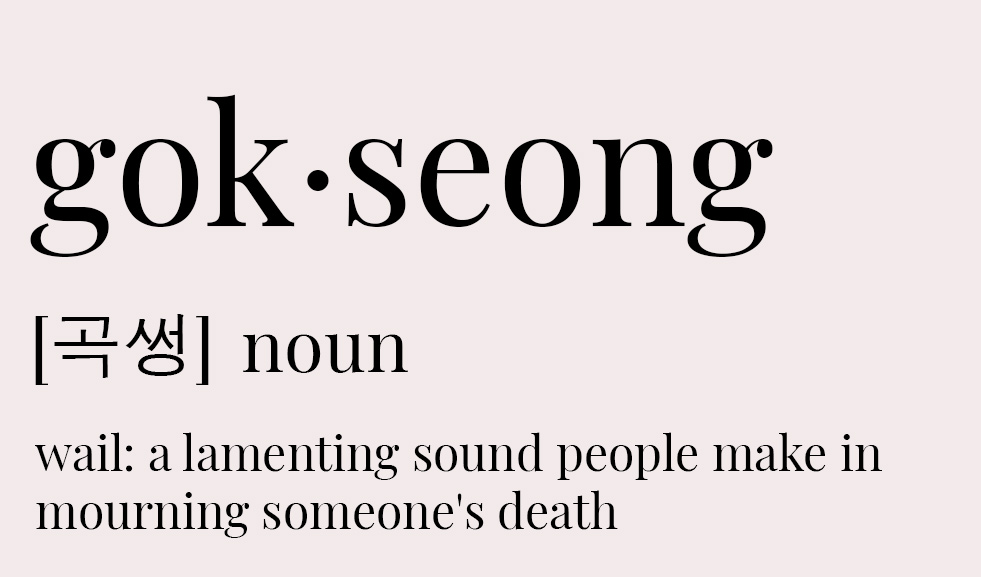
Gokseong isn’t just a town name but the Korean word for “wail.” A noun/verb that’s heavy with melancholy and relates specifically to a cry of grief or anguish. So that sense of “living nature” that Hong-jin felt combines with the somberness of the town’s namesake to create a feeling of apprehension, foreboding, dread that perfectly suits the story.
The international translation of Gokseong to The Wailing lacks the subtlety of the original, forgoing the duality between geography and verb. But, overall, I think The Wailing succeeds as it appropriately conveys the necessary apprehension/foreboding/dread. Something haunting happens in this film, and the title prepares you for that.
The role of faith and Christianity
Na Hong-jin revealed the story for The Wailing materialized following the deaths of several people close to him. The deaths were unrelated. And, tragically, not of natural causes. This cluster of loss took an emotional toll on him. The question he kept coming back to was, “Why did they have to be victims of all people?”
Hong-jin told The Playlist, “I already had the answer for the ‘how.’ What I had to find out was the ‘why’. So I began to meet and talk to the clergy of various religions, which was the starting point for this film.”
You can see this reflected in The Wailing through the fishing metaphor. The Shaman tells us the evil spirit is, like a fisherman, simply seeing what it catches. No rhyme or reason. But those affected find themselves asking, “Why me? Why my family? Why is any of this happening? What can I do about it?”
Initially, Jong-goo is concerned about the strange deaths from a professional point of view, as a police officer whose job it is to solve murders. But then it becomes personal—Jong-goo has a very vested interest in what’s happening to his daughter. We’re in a similar place. When we watch The Wailing, our perspective is more formal, as that of the viewer. But one day we will go from Jong-goo “the detective” to Jong-goo “the father,” trying to make sense of why something awful has happened to us or someone close to us.
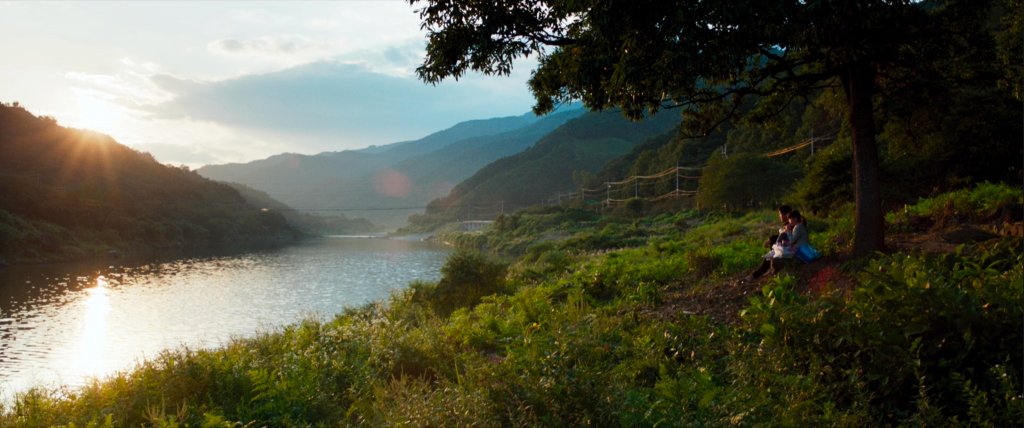
What The Wailing presents us with is a story that’s impossible to fully explain, simply because it denies us necessary information. This reflects real life. There’s a cause-and-effect for everything that happens to us. But most of the time we don’t know what the cause is. Only the effect. That can be something as mundane as why you didn’t get a job you interviewed for. All you know is they rejected you. Maybe it was something you said. Maybe it was something your resume lacked. Maybe you could have done more. But maybe the choice had nothing to do with you. Maybe they always knew who they were going to hire but needed to interview others for legal reasons. Maybe you graduated from the Ohio State University and the interviewer is a University of Michigan fan, so they didn’t hire you because of a school rivalry that has nothing to do with your qualifications. You’ll never know. And you can either ruminate on it or move on. 99% of the time we just move on.
Given Hong-jin’s Christian background, it makes sense he would turn to religion for answers. It also makes sense that the enormity of the situation would trigger enough of a crisis for him to seek answers beyond what he’s familiar with. In The Wailing, neither Christianity nor the Shaman nor the Spirit have the answers. The priest simply tells Jong-goo to trust in the doctors, even though doctors have already failed others. The Shaman actively betrays Jong-goo’s trust. And neither spirit—the Woman in White nor the Stranger—will fully explain themselves to anyone.
Hong-jin said, “I chose religion because I believed that no areas of study or school of philosophy could answer my question mentioned earlier [why did his friends have to die]. I’m a Christian, and if I didn’t believe in the God from the Bible to begin with, I would have told this story in an entirely different way. Perhaps I could have answered the question with scientific reasoning. But I’m not [a] very devout practitioner like the rest of my family, participating in missionary works and such. I sometimes find myself agreeing to the concepts and comments that deny the existence of God. When making important decisions, I seek counseling from the Buddhist monks at temples in the mountains and pray there as well.”
Ultimately, The Wailing examines the complicated nature of faith. That no belief system has all the answers. And that sometimes you have to put your faith into something momentary or unknown that challenges your worldview. Jong-goo can’t do that, as he denies Moo-myung’s assistance because he doesn’t know what she is. The Deacon thinks his faith will protect him when confronting who he suspects is the literal Devil, only for the tables to, quite ominously, turn. One character doesn’t have enough faith and the other has too much. Both Jong-goo and the Deacon end up like Hong-jin struggling with the death of his friends—left to wonder why this happened, what they could have done differently, etc.
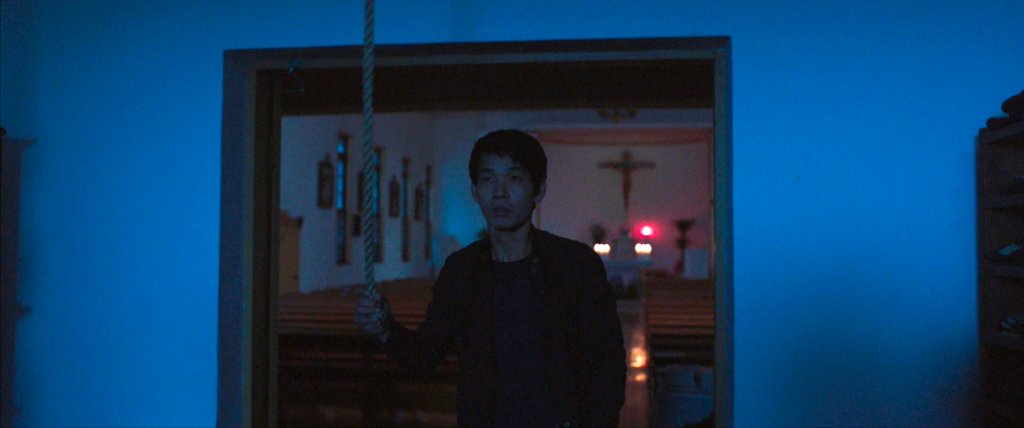
And there’s never a good answer to those questions. Some things are directly consequential. Like if you jump into the ocean with a bunch of raw meat, you’ll probably attract sharks, and that would explain how and why you got bit by a shark. But most things aren’t so obvious. They’re simply the byproduct of being at the wrong place, at the wrong time, with no way of knowing what would happen.
That can sound really bleak and demoralizing. But it doesn’t have to be. Because if you think everything is within your power or control, that can be downright exhausting. That outlook can cause you to blame yourself for things you couldn’t possibly have changed. You can get stuck in the world of what if. What if this. What if that. Instead, if you can accept how out of our control some things are, like cancer or a car crash or a robbery, then it can be easier to find peace and move on and make the best of the aftermath. You don’t have to be the Deacon walking into the Devil’s den. Or Jong-goo destroying his entire family due to an inability to just be patient.
This lines up with another statement Hong-jin made. “There is one thing I wish everyone who watches this film to feel, regardless of who they are: a condolence for those who disappeared after having fallen as victims of the world and for those who are left behind. I sincerely wish this film gives you some time for condolences.”
It’s a powerful thing, the ability to have sympathy for others. And for yourself. To accept that some things we’re powerless to control and all we can do is pick up the pieces and move on.
What’s the meaning of the opening Bible passage?
The Wailing opens with an epigraph. Specifically:
They were startled and frightened, thinking they saw a ghost. He said to them, “Why are you troubled, and why do doubts rise in your minds? Look at my hands and my feet. It is I myself! Touch me and see; a ghost does not have flesh and bones, as you see I have.”
Luke 24:37-39
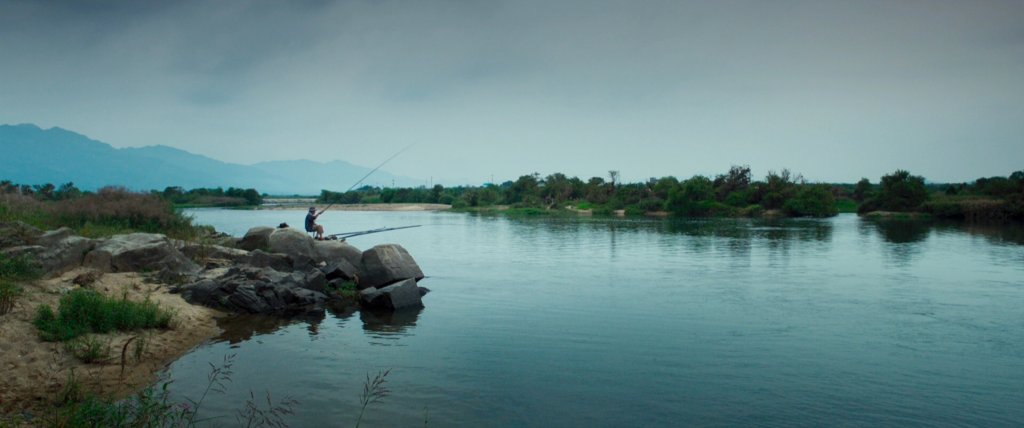
Even for those deeply familiar with the Bible, this epigraph can feel like something from a 19th century novel that’s in the same gothic family as Frankenstein, Dracula, Jane Eyre, The Portrait of Dorian Grey, The Turn of the Screw, or The Phantom of the Opera. It has that quality of terror and horror. That’s because it weaves together both the ethereal and the visceral. It makes you aware of your hands and feet, of touching someone, of their flesh and bone. But anchors you to the idea of the ghost, an entity that’s insubstantial, vaporous, unreal.
That gothic literature vibe is an appropriate one given The Wailing is a story that’s full of ghosts and nightmares and seances.
But the epigraph gains even more meaning when you understand its place in the Bible. Luke 22 encapsulates the Last Supper, Judas betraying Jesus, Jesus’s arrest, and Peter’s denial of Jesus. Luke 23 is the crucifixion, the death of Jesus, and the burial of Jesus. Luke 24 is one of the most important scenes in all of Christianity: the resurrection.
Luke 24 opens with the revelation that the sepulchre that had held the body of Jesus is now empty. Word spreads Jesus has returned to life. Except no one has seen him. People debate and search. It isn’t until verse 15 that Jesus appears. First, to two disciples on the road to Emmaus. Then to his apostles in Jerusalem. It’s his sudden presence that startles them, as it seems Jesus materialized right in the middle of the room.
This is when and where he shows his hands and feet and mentions he’s not a ghost but flesh and bone. To prove the point, he dines before everyone, eating broiled fish and honeycomb. Jesus goes on to say, “This is what is written [in the Scriptures]: The Messiah will suffer and rise from the dead on the third day, and repentance for the forgiveness of sins will be preached in his name to all nations, beginning at Jerusalem.”
After delivering this mission and blessing the apostles, Jesus ascends to heaven.
Now, how does this apply to The Wailing?
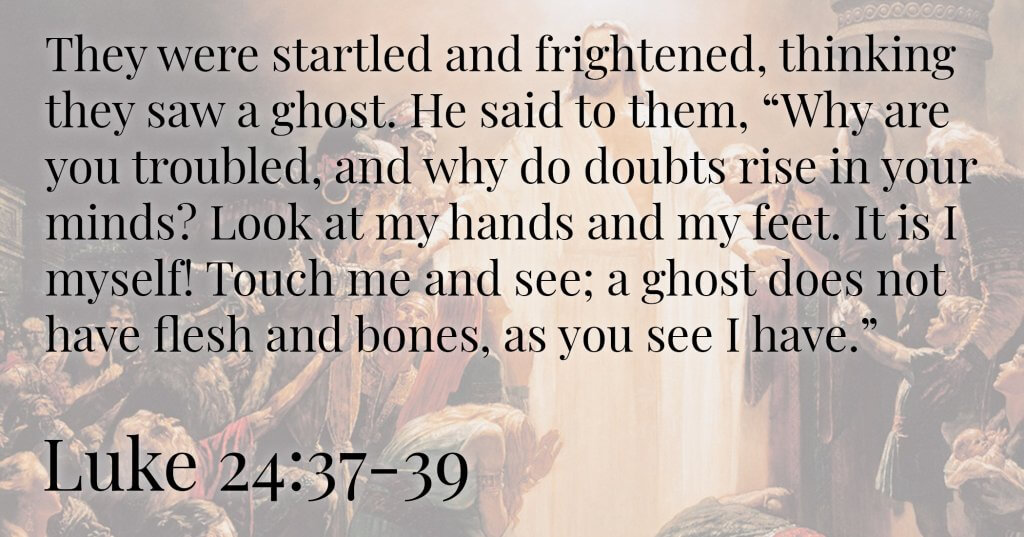
First, much like with the title, the quote is another way to prime the viewer. It tells us we’re dealing with identity, specifically the indecision around someone or something’s identity. Is this person who they say they are? But also, are they even a person?
Think about the Japanese stranger (Jun Kunimura). He’s said to be an evil spirit, a demon, but he appears as human as anyone else. Riding the bus. Buying chickens. Practicing his photography. Throughout the film, it can be hard to accept this seemingly mundane person is a malignant wraith stealing the souls of Gokseong residents. Is he a ghost? Or is he the victim of mistaken identity?
Also think about the dynamic between the shaman Il-gwang (Hwang Jung-min) and the Woman in White, Moo-myung (Chun Woo-hee). Each tells our main character, Jong-goo (Kwak Do-won), a different version of what’s going on, painting the other as an enemy. According to Il-gwang, it’s the Woman in White who is an evil spirit. According to the woman, she’s good and Il-gwang is a servant to the true evil.
As Jong-goo reaches existential and spiritual crisis trying to decide who to believe, the Stranger is in a cave, confronted by the Christian deacon, Yang I-sam (Kim Do-yoon). The Stranger transforms into the devil before the deacon’s eyes while repeating that opening epigraph—Luke 24, verses 37-39. Does the deacon see the Stranger as the devil rather than a human because the deacon wants to see that? Does Jong-goo trust the Shaman over Moo-myung because he has more faith in the human than the “ghost”?
And that brings us to one of the deeper philosophical questions presented by Luke 24:37-39. Does it matter if Jesus was alive again or a spirit? Either way, it’s a miracle. If he was just a spirit, would the Apostles have not taken his last words about the scripture seriously? Would they not have believed what he told them?
Which is the dilemma Jong-goo ends up facing. His faith in what Moo-myung tells him depends upon his knowledge of who or what she is.
- Jong-goo: “What are you? A woman or a ghost?”
- Moo-myung: “Why do you ask”
- Jong-goo: “I need to know…if I can put my faith in you.”
- Moo-myung: “Just believe and your family will be saved.”
- Jong-goo: “What are you?!”
- Moo-myung: “Someone trying to save your daughter. A woman.”

It’s easier for Jong-goo to believe the Shaman and doubt the Woman in White because one is more familiar to him than the other. The same happened with the disciples and apostles of Jesus. They doubted until Jesus calmed their doubts by eating. “Ghosts don’t eat, people eat—so Jesus isn’t a ghost; he’s a person.” Having such proof, the apostles listened to everything Jesus had to say. Unfortunately, the Woman in White doesn’t offer the same reassurance to Jong-goo.
The epigraph isn’t The Wailing’s only reference to the Bible. As you’ll see in the following sections, we dive into connections to the Ressurection of Jesus, the Denial of Peter, and Jong-goo’s sin.
The Resurrection
In The Wailing, the Stranger is an outsider who is vilified, eventually killed, then comes back to life.
In the Bible, Jesus is an outsider who is vilified, eventually killed, then comes back to life.
Without the opening epigraph, making the connection between the Stranger and Jesus would be a bit of a reach. Not every movie or book that has a character come back from the dead is making a Bible reference.
But it’s pretty much a confirmed connection when a story has an epigraph that’s from a Bible chapter that deals specifically with the resurrection of Jesus. Then has a character say the exact words Jesus said after resurrecting. The only way to make it more obvious is to outright say, “Hey, this movie is dealing with religion and faith.”
That leaves us to ask “why?” Why connect the Stranger, of all people, to Jesus? Isn’t Jesus good and the Stranger evil?
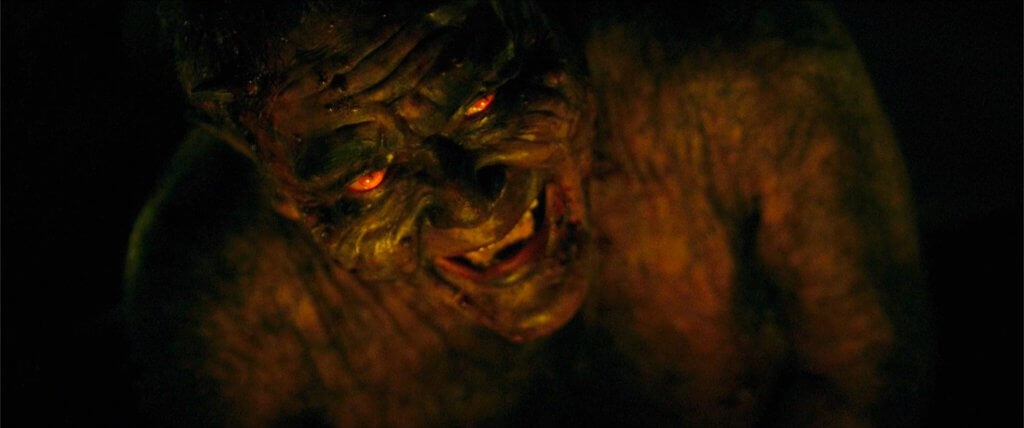
Na Hong-jin is a practicing Christian. So I don’t think he made the connection to be snarky or negative or sacrilegious. Rather, I think it ties back to why he made The Wailing—he was trying to understand the unnatural deaths of several close friends. And struggling to understand God’s role in such events. Are such things part of God’s plan or not? Or are there other forces at play?
So by connecting Jesus to this character who may or may not be responsible for people dying, Hong-jin recreates his feeling of spiritual crisis. And that leaves viewers in a similar state. Uncertain of who did what and why.
We’ll come back to this soon.
The Denial of Peter
Peter’s denial of Jesus is the last of The Wailing’s majorly relevant Biblical references. In Luke 22, Jesus has his Last Supper with his apostles. Throughout the meal, he talks about how he’ll soon be dead, and even announces that “the hand of him who is going to betray me is with mine on the table.” This causes the other apostles to speculate on which one of them is the betrayer (looking at you, Judas). But that evolves to who is the best apostle. Jesus is quick to shoot down such aggrandizing talk. Saying “the greatest among you should be like the youngest, and the one who rules like the one who serves.”
Following this speech, Jesus addresses one apostle in particular—Simon Peter. He says, “Simon, Simon, Satan has asked to sift all of you as wheat. But I have prayed for you, Simon, that your faith may not fail. And when you have turned back, strengthen your brothers.”
This is a bit shocking to Simon. To hear that he might abandon Jesus. In response, Simon says, “Lord, I am ready to go with you to prison and to death.”
It’s a brave claim. One that Jesus smacks away with a stark declaration: “I tell you, Peter, before the rooster crows today, you will deny three times that you know me.” And that’s exactly what happens. Jesus gets arrested. Someone says Simon was with Jesus. Simon denies it. “I don’t know him.” Twice more this repeats. Right after the third denial we’re told, “Just as he was speaking, the rooster crowed. The Lord turned and looked straight at Peter. Then Peter remembered the words the Lord had spoken to him…And he went outside and wept bitterly.” Damn.
The Wailing makes a direct connection to this trial. The Woman in White asks Jong-goo to wait for the rooster to cry three times. If Jong-goo can maintain his faith for that long, he’ll save his family. But fear overpowers him just like it did Simon Peter. Simon feared being arrested and judged and sentenced alongside Jesus. Which led to the denial. While Jong-goo fears placing his faith in the wrong source, torn between the Woman in White and the Shaman.
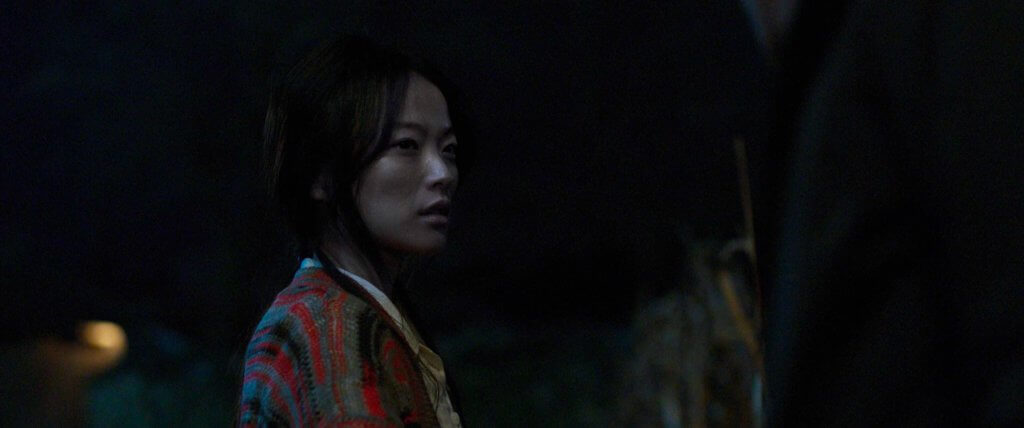
The reference to Peter’s Denial is one of the ways in which director Hong-jin mixes Christian and Asian mythology to create a world that feels somewhat at odds with our expectations and points of reference. Neither the Christian nor Asian mythology is elevated over the other. One isn’t right, one isn’t wrong. Which is one of the difficult things about The Wailing, as you keep looking for something that’s clear-cut and relatable.
If you try to read the movie as purely Christian or purely Asian mythology, your search for meaning could lead you to dead end after dead end.
So what should you do?
What was Jong-goo’s sin?
During Jong-goo’s final encounter with Moo-myung, he says, “Let me ask you one thing. Why in God’s name is [the Stranger] doing this?” It’s not enough for Jong-goo to know how to save his daughter, he wants to know why this has happened at all. Why him? Why his daughter?
The Woman in White responds with: “Because her father has sinned… Her father suspected another. He tried to kill him, and he finally succeeded.”
This makes zero sense to Jong-goo because the events are out of order. He screams, “My daughter got sick first [implying the Stranger targeted them first]!” Then his anger wanes as he tries to rationalize the paradox. “How does that… How can that possibly…. How can that be?”
The sin Moo-myung refers to is when Jong-goo and his crew tossed the Stranger over a guardrail to his “death.” That scene is one of the great points of contention in The Wailing. If the Stranger is an evil spirit, a demon, the devil, then why was that a sin? If it is a sin, does that mean the Stranger wasn’t an evil spirit? Not to mention, it was Moo-myung chasing the Stranger towards the road. Didn’t she play a part? Does that mean she’s good or bad or what?
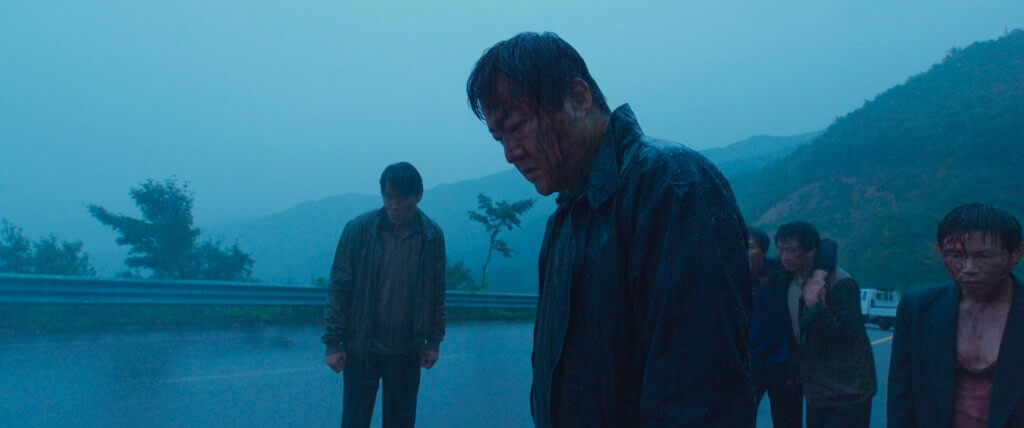
Perhaps the best place to start is to take a step back and say: regardless of whether the Stranger is evil or not, he still has the form of a man. And killing someone, even if you think you have cause, is a sin. After the Stranger landed on Jong-goo’s car, Jong-goo had a choice. He could take the moral high ground and help someone because they’re in need. Or punish them because he thought they might be evil.
This kind of moral test is commonly found in the stories of Christianity, Judaism, Islam, and other religions. Does the protagonist stay true to the teaching of the religion? If so, they’re rewarded. If not, they’re ruined. Either way, they’re inspirational as to what someone should do or not do in a given situation.
With that in mind, we can answer the seeming paradox that flummoxes poor Jong-goo.
Yes, his daughter got sick first. But that didn’t mean she would die. The evil spirit couldn’t outright kill her. Rather, it had to escalate the situation, go through a ritual, corrupt the target. Only then could it feed. That means if the family maintained its innocence and faith, then it is possible to survive. Especially if you have a protector like the Woman in White actively trying to save you.
Once Jong-goo committed sin and “killed” the Stranger, he lost his moral innocence. He failed the test.
The paradox also reminds us of Hong-jin’s question about why his friends, of all people, had to die. Even if you get an answer, it can be unsatisfactory and do nothing to make you feel better about what happened. In fact, it can leave you more perplexed. It feels like The Wailing is saying that an answer might not even be worth pursuing.
Why couldn’t Jong-goo go home?
Jong-goo’s sin stained him. This is why the Woman in White wants to keep him away from his family. Because if she’s able to maintain a sense of purity at the household, the demon can’t kill. The window of opportunity will pass. The evil ritual will fail.
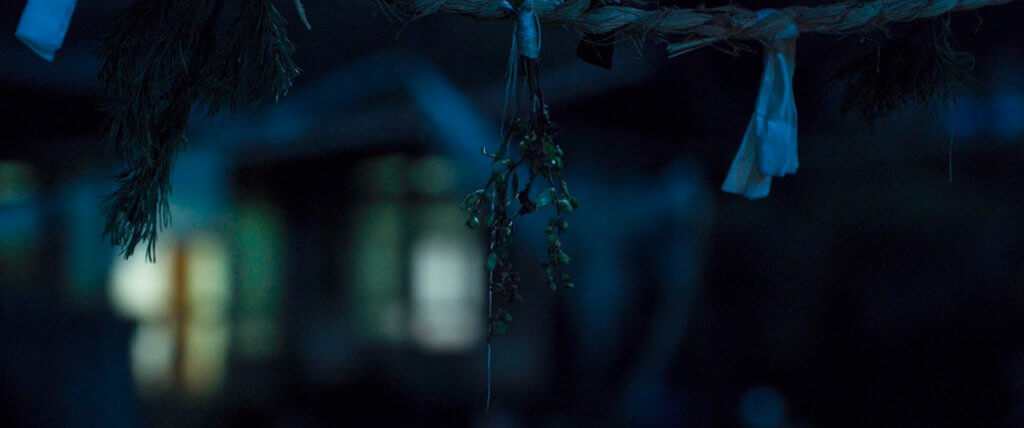
This is why The Wailing shows us the sprig on the front gate. The same way the Shaman and Stranger have totems and items related to their rituals, so does Moo-myung. For her, there’s no large ceremony. No crows hanging upside down. No sacrifice. Just something from nature that can carry the spirit of purity and innocence and thus repel the demon.
And that’s why it withers when Jong-goo crosses the threshold to his home. His sin breaks Moo-myung’s protective spell, allowing the demon to feast.
Does the evil spirit have a ritual?
It does seem the Stranger has a ritual he must perform in order to kill someone. In normal circumstances, the ritual looks something like this:
- Evil Spirit finds a person to curse, using an item belonging to that person.
- Evil Spirit begins to haunt the person.
- The demon takes possession of the person and kills.
- Evil Spirit or Shaman takes a photo of the victims, completing the ritual.
But this process gets upended in Gokseong thanks to the Woman in White. She’s trying to protect the villagers. Which explains why the Evil Spirit involves the Shaman—it needs someone to counteract the Woman in White’s protection.
So this is how the process plays out in Gokseong.
- Evil Spirits finds a person to curse.
- Begins to haunt the person.
- Woman in White tries to protect the person.
- Spirit increases the intensity of the haunting.
- Family calls the Shaman to try and remove the curse.
- The Shaman, instead, removes the Woman in White’s protection.
- Demon takes possession and kills.
- Spirit/Shaman takes a photo, completes the ritual.
And this is how the process plays out for Jong-goo and his daughter, Hyo-jin (Kim Hwan-hee).
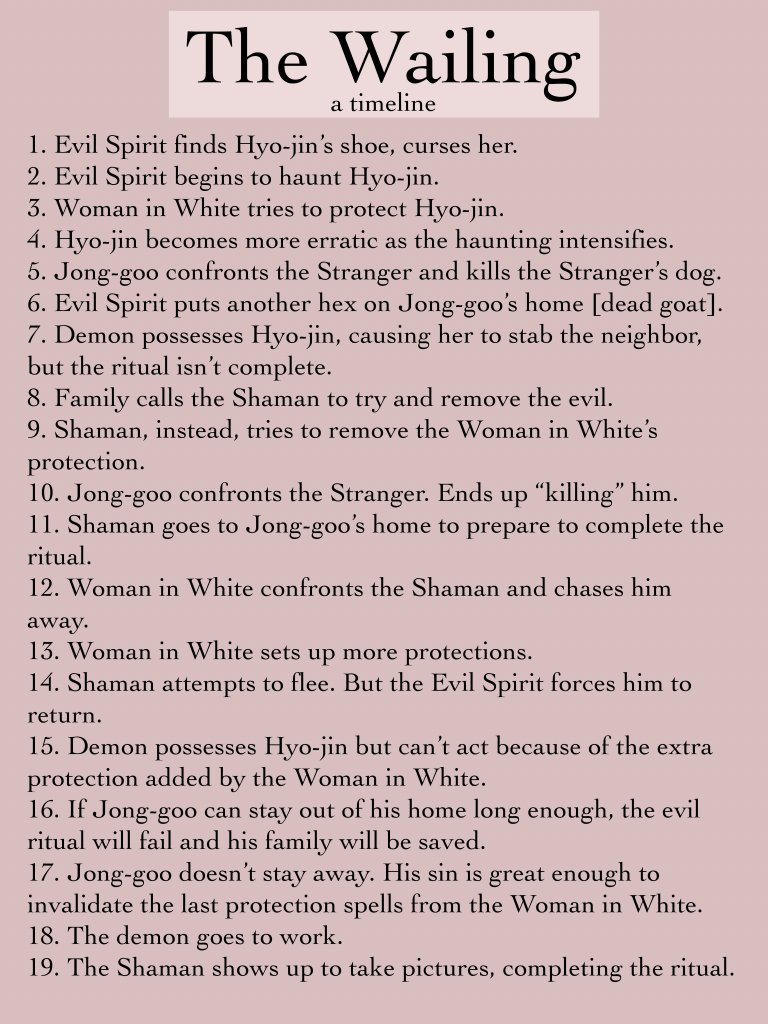
Just in case you can’t see that image, here’s that timeline that spelled out in text form:
- Evil Spirit finds Hyo-jin’s shoe, curses her.
- Evil Spirit begins to haunt Hyo-jin.
- Woman in White tries to protect Hyo-jin.
- Hyo-jin becomes more erratic as the haunting intensifies.
- Jong-goo confronts the Stranger and kills the Stranger’s dog.
- Evil Spirit puts another hex on Jong-goo’s home [dead goat].
- Demon possesses Hyo-jin, causing her to stab the neighbor, but the ritual isn’t complete.
- Family calls the Shaman to try and remove the evil.
- Shaman, instead, tries to remove the Woman in White’s protection.
- Jong-goo confronts the Stranger. Ends up “killing” him.
- Shaman goes to Jong-goo’s home to prepare to complete the ritual.
- Woman in White confronts the Shaman and chases him away.
- Woman in White sets up more protections.
- Shaman attempts to flee. But the Evil Spirit forces him to return.
- Demon possesses Hyo-jin but can’t act because of the extra protection added by the Woman in White.
- If Jong-goo can stay out of his home long enough, the evil ritual will fail and his family will be saved.
- Jong-goo doesn’t stay away. His sin is great enough to invalidate the last protection spells from the Woman in White.
- The demon goes to work.
- The Shaman shows up to take pictures, completing the ritual.
Why did the Shaman say “the rat fell into the trap”?
Let’s put that line another way. Instead of “The rat fell into the trap,” let’s go with, “The fish has taken the bait.”
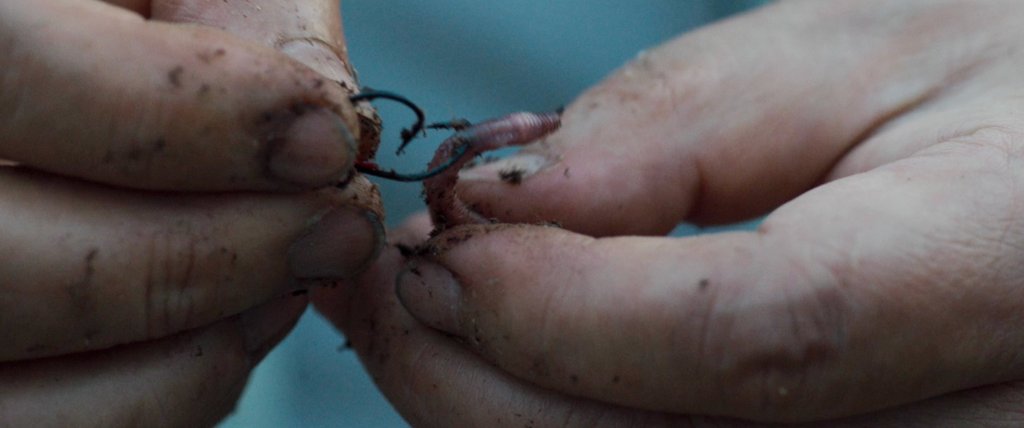
Remember, The Wailing opens with the Stranger fishing. We get a very intense close-up of him putting a worm on two hooks. This is the bait he’ll use to catch fish.
You’ve probably heard someone say “First impressions matter.” It’s generally true. And the reason why a lot of filmmakers take pains to make the first shot and first scene meaningful. They set the stage for the story that follows. Usually, these first impressions convey some vital aspect of the film. Whether that’s tone or theme or both.
The first shot of The Departed shows two random men fighting in the street. Lo and behold, the main plot of The Departed is the cat and mouse game between Leonardo DiCaprio and Matt Damon. One is a police officer who has infiltrated a crime organization. The other is part of the crime organization and has infiltrated the police. The opening shot isn’t crucial to the plot or anything. It could be cut and it wouldn’t affect the story at all. There’s no narrative reason for that shot to be there. So why have it? Because it psychologically primes the viewer, whether they realize it or not, for this confrontation between DiCaprio and Damon.
The Wailing is similar. Remove the opening fishing scene and the story doesn’t change. It’s not narratively vital. The reason you have the scene is because it tells the viewer something about what they’re about to see. A man baits a hook. That’s it. It’s ominous. And maybe it’s trying to tell us something, but can’t possibly know what that something is.
Until Il-gwang, the Shaman, explains.
- Jong-Goo: Why did it have to be…
- Il-Gwang: Your daughter? What sin did that young girl ever commit?
- Jong-Goo: Yes.
- Il-Gwang: If you go fishing, do you know what you’ll catch?
- Jong-Goo: No.
- Il-Gwang: He’s just fishing. Not even he knows what he’ll catch. He just threw out the bait, and your daughter took it. That’s all it was.
Now the opening scene makes more sense, right? We saw the Stranger bait two hooks with a worm. It’s exactly what he’s doing in Gokseong. Putting people on hooks and seeing what he catches.
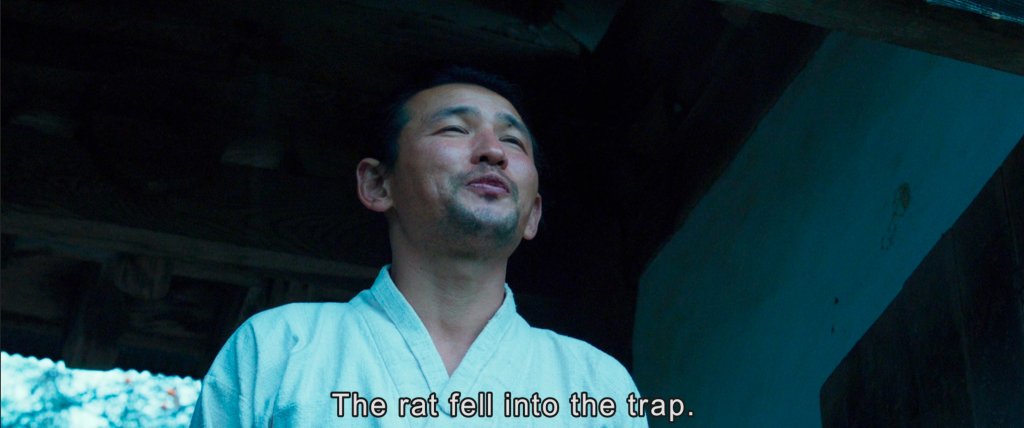
When Jong-goo “kills” the Japanese man, that’s when we cut to Il-Gwang saying “The rat fell into the trap.”
By that, Il-Gwang, with his Shaman insights, is aware that Jong-goo committed a serious sin. Which is exactly what the Evil Spirit wanted. The sin will allow the demon to overcome the Woman in White’s protection and complete its murderous ritual.
Was the Shaman good or really working with the Stranger?
A deleted scene clarifies this. It shows the Stranger at a bus stop on the side of the road. Then Il-gwang pulls up and the Stranger gets in and they ride off. As the car disappears into the distance, the Woman in White emerges from the side of the road and watches them leave Gokseong.
But Hong-jin said the scene wasn’t necessary because viewers had already been given enough information to understand Il-Gwang and the Stranger had worked together.
The most direct is Moo-myung telling Jong-goo that the Shaman works with the Evil Spirit.
If that wasn’t enough, the Shaman shows up to the murder scene and takes photos of Jong-goo’s dead family.
And if that wasn’t enough, the Shaman has, in the trunk of his car, all of the Stranger’s photos. You know, the terrifying stalker photos of people who died. It’s very incriminating.
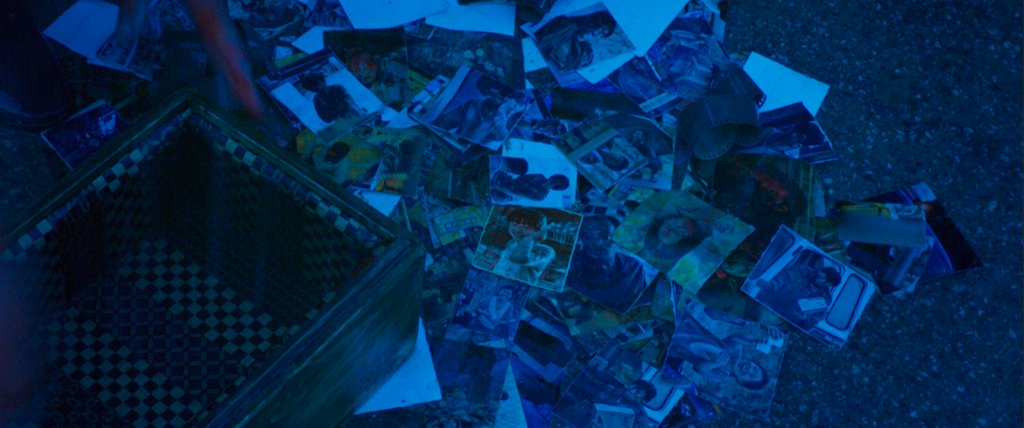
The other big piece of evidence is the murder of Park Choon-bae [also written as Park Chun-bae] (Kil Chang-gyoo). The scene happens after the Shaman has started working with Jong-goo’s family. He tells Jong-goo that the man Jong-goo upset is no man at all—it was a ghost. Then we cut to the police at the scene of yet another murder. Multiple people are dead. One’s even pulled from a well. The cops look at a picture of the murder and say his name is “Park Choon-bae.”
It may seem like nothing more than a reminder that the Stranger is still killing people. But there’s more to it. The Choon-bae home looks like it just hosted a party. There are colorful flags and other decorations. Drugs. Multiple tables with food and flowers and even a pig. There are mats with swords on them. Easy to overlook on a first watch. But maybe you’ll recognize it as all the same stuff Il-Gwang just had at Jong-goo’s house.
The implication here is that Il-Gwang just did this same seance/ritual for someone else. And it didn’t work. The demon still came and murdered everyone. Maybe that’s coincidence. Maybe it just shows how powerful the Evil Spirit is. But given what we know about the relationship between Il-Gwang and the Stranger, it’s another piece of evidence the two are working together. That the Shaman can actually be part of the ritual that causes the demon’s deadly awakening.
The necessity of the Shaman would be why the Stranger stops him from fleeing after the Woman in White succeeds in chasing him away. Il-Gwang was so scared that he literally packed up his office and left town. Until that swarm of locusts (note how Biblical that is) engulf his car, making it impossible to drive. It turned out to only be a vision, but a vision intense enough and meaningful enough that he got back in his car and returned to Gokseong to coax Jong-goo into completing the evil ritual.
Though you might be asking, what about the exorcism, wasn’t that killing the Stranger?
The exorcism
The Wailing’s death hex scene (aka, exorcism) is the one that probably trips people up the most. If the Shaman was working with the Stranger, why perform this exorcism that appears to almost kill the Stranger? Doesn’t that prove the Shaman was actually good?
It would if we weren’t being lied to.
The reason we think the Il-Gwang’s death hex is hurting the Stranger is because of how Hong-jin cross-cuts from one to the other. It makes the viewer think that Il-Gwang nailing the wooden figure hurts the Stranger. But what if I told you that’s not what’s happening? What if I told you, in actuality, that was just Hong-jin purposefully trying to confuse us?
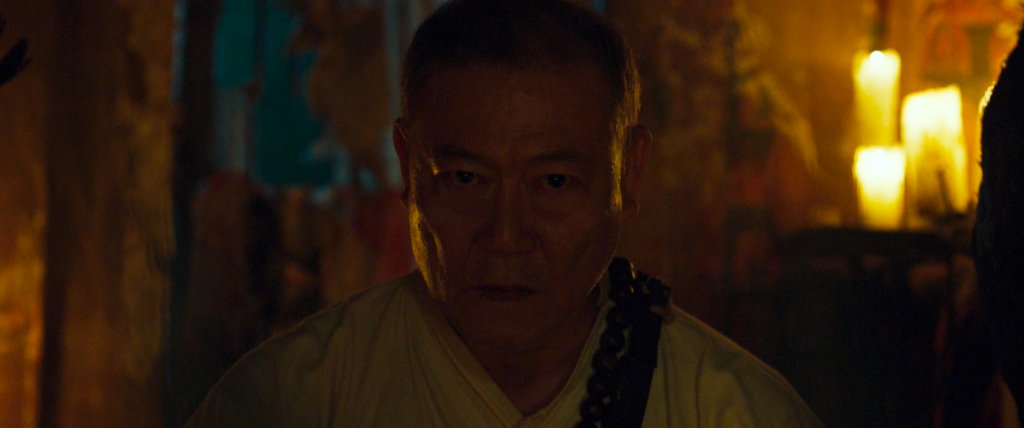
At the time the Shaman’s doing his thing, the Stranger is in the middle of a ritual of his own. He’s bought the chickens. He’s strung them up. He’s done his waterfall purification ritual. Then we see him in his curse cabin, drumming and chanting and it’s all very intense. Because of the cross-cuts, it’s easy to think he’s simply trying and failing to counteract Il-Gwang’s exorcism.
But, really, the Stranger is doing something completely different. On his shrine we don’t see Hyo-jin or Jong-goo. Instead, we see a photograph of Park Choon-bae dead in a truck. Whatever the Stranger’s up to has to do with Choon-bae’s body. We even cut to the truck and the dozens of candles the Stranger’s lit around it. Deep into the ritual, Choon-bae’s body even stirs. The dead man has awakened.
It’s right after Park Choon-bae comes back to life that we cut back to the Shaman stabbing the totem. Then Hyo-jin screaming in pain. Then back to the Stranger, who begins to convulse and cry out. The Wailing wants us to think that stabbing the totem hurts Hyo-jin which hurts the Stranger. It’s a harmless manipulation done to heighten the eventual surprise that the Shaman is bad. Really, what the Shaman’s doing has no effect on the Stranger. They’re involved in two completely separate rituals.
What the Shaman is doing, as we’ve said before, is removing Moo-myung’s protections. That wooden totem he cuts down and starts stabbing? That’s called a jangseung. Which means “village guardian.” As the University of Sheffield explains, “Korean totem poles (Jangseung) were used traditionally to protect villages from evil spirits…. It was believed that outside the village, the spirits that couldn’t go to the afterlife and the gods that transmitted smallpox and other contagious diseases watched for an opportunity to go after the residents…. Today, there are still many villages who erect the Jangsin and hold ancestral rituals.”
If the Shaman is trying to undo the protection of the Woman in White, the guardian spirit of Gokseong, then of course he’d be chopping down a jangseung. The jangseung literally represents the village guardian and protects against evil spirits. With that information, Il-gwang’s stabbing is a lot more terrifying than good.
To that end, I imagine Hyo-jin’s reacting to the protections on her body that had prevented the demon from total possession. That’s why she’s in so much pain.
So we know what the Shaman was doing. But what was the Stranger doing?
Why does Park Choon-bae become a zombie?
From The Wailing’s beginning up to the exorcism scene, the Stranger is always very calm. Very stoic. He barely reacts to Jong-goo’s multiple home invasions. Even when Jong-goo kills the Stranger’s dog. You’d think there’d be anger or fear or something. But he’s unfazed by it.
After the exorcism scene, the Stranger is completely out of sorts. He wakes up and looks surprised. Then he’s running through the woods, moving with such haste that he’s slipping and falling. When he arrives at Park Choon-bae’s truck, he has fresh blood all over his head and face—probably from falling and branches whipping him. That’s how much of a rush he was in to get to the truck.
When he gets there, he opens the door to find Park Choon-bae’s gone. There’s legitimate shock. Footprints lead from the car back up to the house. So the Stranger follows. Then the whole confrontation between the Choon-bae zombie and Jong-goo and crew takes place. Once that’s done, the guys see the Stranger and chase him.
It’s not that surprising the Stranger’s so worried. Jong-goo and friends are obviously angry and may potentially kill him. But I think this is another clever trick by Hong-jin. He wants us to think this is just the Stranger finally losing his cool and showing fear. That’s humanzing. It’s the kind of thing that will make many viewers think the Stranger may not be an evil spirit afterall. That Jong-goo has gotten everything wrong.
But in hindsight, once you’ve watched The Wailing all the way through, you know better. The Stranger was an evil spirit. Which only makes this scene all the more puzzling.
Until you realize Jong-goo’s not chasing the Stranger. He’s chasing Park Choon-bae.
That’s right.
The Stranger’s ritual was a transference. The soul of Park Choon-bae entered the body of the Japanese man. While the Evil Spirit in the Japanese man entered the body of Park Choon-bae.
That’s why the “Stranger,” in a complete panic, runs straight for Choon-Bae’s truck. That’s why he chases after the body. It’s why he’s so terrified of Jong-goo and crew. And it’s why he chases after the Woman in White.
Remember, when we first see Moo-myung, she’s wearing Park Choon-Bae’s jacket. Later, we see that jacket on Choon-bae’s corpse. What this probably means is that Moo-myung had tried to protect Choon-bae from the Evil Spirit, using his jacket as a means of connection (the same way we see she has Hyo-jin hair clip (then the restaurant hostess’s sweater)). Maybe something happened that caused her to lose possession of the jacket? Or maybe Choon-bae had multiples (they seemed like work jackets). Either way, we know the Shaman got involved and broke the protection, allowing the demon to kill the Choon-bae family.
It’s likely that Choon-bae recognizes Moo-myung, the same way Jong-goo will a little later. Maybe he blames her for what happened? Maybe he’s upset because he remembers killing his family and is angry at her? Whatever the specific reason, he chases her.
This is why Jong-goo throwing the Stranger’s body off the cliff is important. Because it wasn’t the Evil Spirit in the body. It was Park Choon-bae. That’s why it’s a sin and why the Shaman says “The rat has taken the bait.”
“Okay. That all makes sense. But how does Choon-bae end up landing on the truck?”
Why does The Stranger land on the truck?
To me, this is the most confusing thing in the movie. I wish I had a good answer. We see Stranger-bae running after the Woman in White. Then next thing he’s landing on the truck.
Did she throw him? Did he throw himself?
Him throwing himself doesn’t make a lot of sense. Because if he wanted to die, why not just let Jong-goo and friends kill him earlier? Maybe he realized something was wrong and is actively trying to end his life?
And if Moo-myung threw him, what does she accomplish? Doesn’t that make her an accomplice to Jong-goo’s sin?
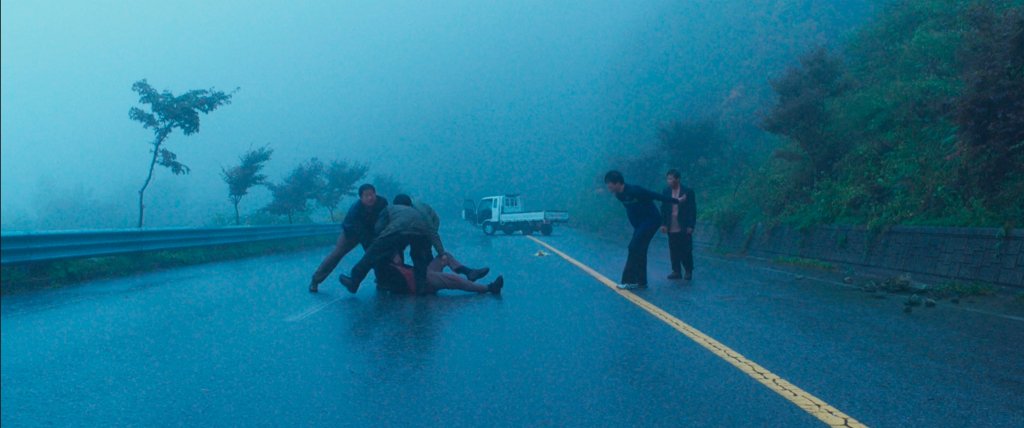
Hong-jin has left this completely unanswerable, as far as I’m aware. There’s no deleted scene. There’s no interview quote. There’s not a speech from a character that explains the event. Or a vague scene that provides a clue to the puzzle.
The main benefit of not showing what happened is that it can sow doubt about the Woman in White. It sets up Il-Gwang claiming she’s the real Evil Spirit. When he says that, the first thing many will think of is her standing on that cliffside and the uncertainty they felt about her then. Maybe she did set-up the Stranger? Maybe she is the evil one?
You do need a scene to create doubt in the viewer. It’s the same reason we have the Park Choon-bae body swap—it creates doubt in the Stranger’s guilt. And by casting doubt on the Woman in White’s innocence in the same scene it can feel like a big revelation. “The Stranger was good! Moo-myung is actually bad! What will happen next!?” The Wailing really is a masterwork in manipulating viewer expectation.
But I do wish this particular manipulation was a little less clunky.
Who were the women visiting the Shaman?
While Jong-goo is about to throw the Park Choon-bae version of the Stranger off the cliff, we see the Shaman meet with two women. One older, one younger. The younger woman looks afflicted and has the same rash as the Stranger’s other victims. It’s probably safe to assume this is a business consultation. That the women want to hire the Shaman to save them from this evil.

We actually saw the younger woman earlier in The Wailing. About 45-minutes in, following the scene where the hunter gets struck by lightning and Jong-goo sees the first murderer, Heung-gook (Jeong Mi-nam), die in the hospital after terrifying convulsions. Jong-goo and his partner, Oh Seong-bok (Son Gang-guk), go to a local restaurant to decompress. They notice a woman across the room, the bar’s hostess, drinking with some of the other patrons. The tell-tale red rash visible on her neck.
We don’t see her again until her and her mother’s visit to the Shaman. But we do see that Moo-myung, during her final confrontation with Jong-goo, wears the Hostess’s sweater. The sweater joins Park Choon-bae’s jacket and Hyo-jin’s hair clip as items the Woman in White has possessed.
This seems to confirm that some kind of physical item is necessary to link a spirit to someone else. The Stranger needs an item to enact his curse. While Moo-myung needs it to try and guard against the curse. Unfortunately, Jong-goo recognizes that the sweater belongs to the hostess, right after he notices Hyo-jin’s hair clip on the ground where Moo-myung had been standing. His thoughts then flash back to Park Choon-bae’s jacket. He thinks he’s put 2 and 2 together. But unknowingly he misreads the situation. Moo-myung can either tell what he’s thinking or knows what he’s thinking, because she says, “That’s not it.”
So the Hostess isn’t a huge part of the story. But her presence is consequential in that it helps break Jong-goo out of his indecision when trying to decide between Moo-myung and Il-gwang.
Did the mushrooms have anything to do with anything?
Mushrooms are the first theory the police have about what’s going on. That’s because the first killer, Heung-gook, had mushrooms in his system. The official theory is someone’s poisoning people with a mushroom-based tonic. The conclusion of this subplot is a news report that says a suspect had been arrested.
In our view, this is a red herring. We should know there’s something far more intense than mushroom tonic going on. But the inclusion of this minor subplot adds to the idea that people scramble for answers. And that we can often blame the wrong people. Whoever the police arrested couldn’t have been the one killing everyone. It’s an unassuming moment of injustice. Another instance of people getting scared and manufacturing someone to blame.
Which I’m sure ties back to Hong-jin’s attempt to process why his friends died. He wanted someone or something to blame. “They died because of this person, or this choice, or this event.” But you can see how problematic leaping to such conclusions can be. Maybe the mushroom tonic person was guilty of something? But they certainly weren’t guilty of these murders. Which makes them yet another victim, and shows how clueless not just individuals but society can be when trying to make sense of things.
Was Jong-goo’s family dead before he left the Woman in White?
This is an interesting point. It doesn’t take Jong-goo very long to travel from the front entrance to his home, through the yard, to the house, and into the kitchen. The demon had already attacked. Everything is chaos and blood. The wife and mother-in-law both heaps of red.
I’m sure there are viewers who question this. The Woman in White told Jong-goo he’d save his family and trap the demon if he waited for the rooster to call three times. With that information, it’s safe to assume the possessed version of Hyo-jin couldn’t act until Jong-goo crossed the threshold and broke the protections. So why is everyone already dead by the time Jong-goo gets home?
I see two main ways to interpret this. One simple. One complicated.
The simple interpretation is Hong-jin made a creative choice for dramatic effect, hoping people wouldn’t notice the timing issue. There’s nothing more to it than that. If the demon version of Hyo-jin attacked when Jong-goo came home, then the scene can tip into action. Does Jong-goo wait outside while he hears his wife and mother-in-law killed? Does he rush in and try to stop it? Neither scenario is better or worse. They’re just completely different energies. The version Hong-jin went with is much more reflective and allows for Jong-goo to process what’s happened and sell his reaction. It feels more like someone having to come face to face with the consequences of his actions rather than a final showdown.
The complicated interpretation brings us back to the role of the Woman in White. She said Jong-goo could save his family, but his family was already dead by the time the rooster started calling. So does that mean she never planned on saving Jong-goo’s family. Why? Maybe she was also evil? Maybe she cared more about trapping the demon than saving people, justifying Jong-goo’s family as collateral damage? That would play into the fishing metaphor, right? She used Jong-goo’s family as bait.
If Moo-myung was actually evil, I feel like we wouldn’t see her so upset after Jong-goo runs off. It seems like her grief is genuine. That could be grief for Jong-goo’s family. It could also simply be her frustrations at almost catching the demon only for Jong-goo to ruin it, knowing that means others will die.
Personally, I lean more to it being a creative choice for dramatic effect. I do think Moo-myung was representative of a guardian spirit rather than being yet another evil. If she were also evil, that would mean The Wailing lacked hope altogether. Jong-goo would have been damned had he chosen to trust the Shaman and damned if he had chosen to trust Moo-myung. Which can work if you want to make a truly nihilistic statement about the world. But I don’t think that’s what The Wailing wants to say. I think The Wailing wants to convey how hard it can be to put your faith in someone or something you don’t understand. Rather than saying no matter where you put your faith you’re wrong. It’s a bleak movie, but not that bleak.
Main theme of The Wailing
Overall, what we see is a movie that’s concerned with the randomness of death and how we people react to such things. Who do we blame? How do we cope? How much control do we really have over what’s happening?
And all of that ties back to faith. Who and what do you have faith in? Especially in these situations. Do you have faith in religion? In a village guardian? In a shaman? Do you have faith in doctors and the police? Do you have faith in the rumors you hear from people you know? Do you have faith in someone from outside the community? And is it possible to have too much faith? Look at the deacon who ends up walking into the Devil’s den.
As defeating as The Wailing can feel, from the title down to the fate of the main characters, there is a silver lining. Despite the evil entity randomly targeting people, there’s a good entity trying to save people. Good doesn’t always win, but it can. Sick people do get better. Someone in an accident survives because they moved 1-inch to the left at the last minute. Driving to a movie may seem uneventful to you, but your safe travel could be the byproduct of so many things going in your favor rather than against you.
So even though there are so many dire things that happen in The Wailing, I find it kind of hopeful? Because it seems to be saying that often our fate is out of our hands. All we can really do is live our best lives and let the Strangers and Moo-myungs of the world fight it out. That what they’re doing is beyond our ability to solve. Instead of feeling powerless about that, we should support one another, honor one another, show compassion to one another, and make the best of being small fish in a big pond.
Now, what do you think?
Did we get it right? What did we miss?
Let us know in the comments below! And remember to check out our recommendations for movies like The Wailing.

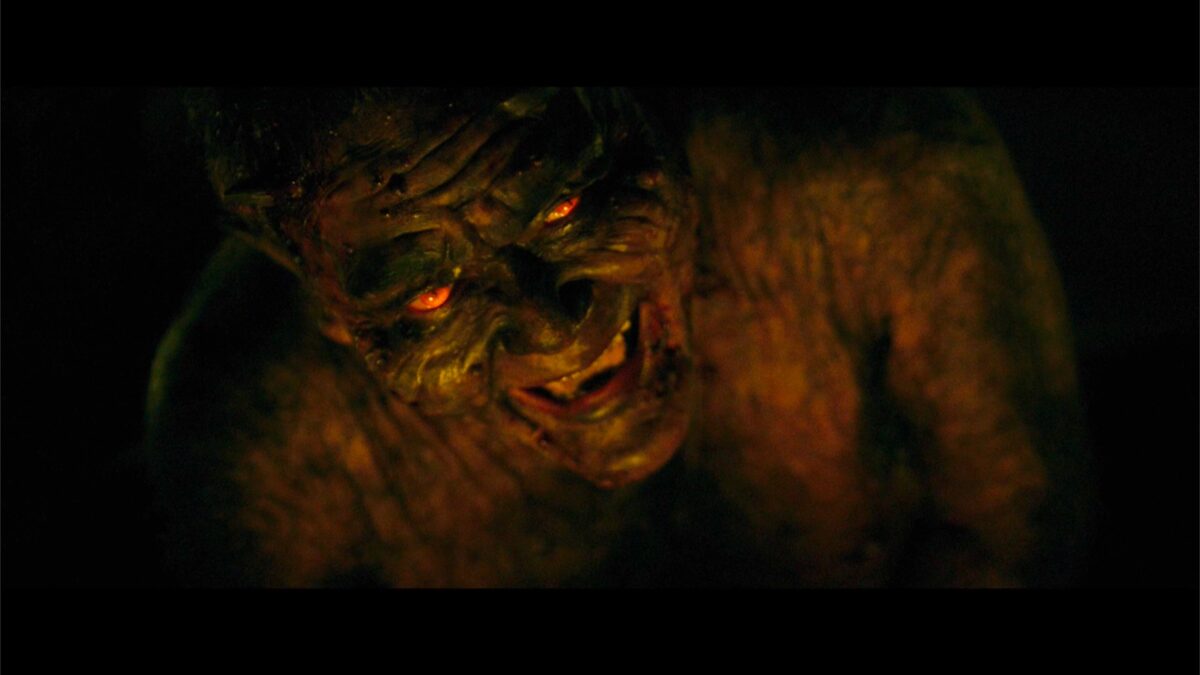
Wow, that was a great analysis ! I just saw the movie in Brussels Korean film Festival tonight and was craving for more informations, thank you so much !!
There is also something I can’t explain. There is this scene where we learn about the rape the stranger commited on the woman who hanged herself.
When the rape is described, we can clearly see that there are people behind the stranger and the woman while the rape is commited. No one seems to help her.
And then, even after that, the stranger still remains free, as everyone seems to know he raped the woman. The police does nothing, and even when they learn about this fact in the restaurant, they don’t really seem to care.
But we should know, then, that the Stranger is some kind of evil, like, I mean, he raped a woman, we could keep this in mind. So why do we doubt that much during the movie ? And why do we (both the characters and us) totally forgot about this information, or, at least, consider it as insignificant
?
Maybe I’m overthinking, but seeing how Na Hong Jin describes the justice/police in The Chaser, I was thinking that it could be some kind of criticism of that system letting a rapist (and the devil himself actually) free, and another play with our conscience : we are always trying to look for the good and for the redemption inside people, so we are more likely to close our eyes and forgot about the rape. I think this is a fact : we don’t want to accept that the Stranger is the devil, until the last minute, when we are forced to admit it. During the movie, when Na Hong Jin was telling us that maybe the shaman is right and the woman in white is evil, I felt a bit like “we should know and, given the informations, we are able to know, but in fact we don’t want to know, we want to hope”.
I’m not sure at all. But this forgotten narration of the rape stays in my mind ! I mean, it must be significant, and what was the point…? What do you think ? I would love to hear from you.
Have a nice week-end everyone ! (and sorry if my english is not perfect, I’m french !)
Hey there, I’m not really that knowledgeable about the movie and Korean / Japanese history in general, but I think that the theme of the rape was chosen for a reason.
Indeed, during the invasion of Korea by the Japanese (from 1910 to 1945), a lot of women were raped, and this is still a point of dissent between Koreans and Japanese nowadays.
Thus, I guess that the image of the rape was a way to tie this into this history, and makes it look like people are just projecting evils on the Stranger, as it would be kinda cliché to accuse a Japanese man of rape out of all the crimes he could have committed. This really bugged me during the movie, and made me think that, perhaps, the Stranger was being framed, and I think that it was the director’s goal with this particular accusation.
Oh, and your English is pretty much perfect, don’t worry about it 🙂 (Coming from another french 🙂 )
I’m thinking the girl killed the family at the moment the dad decides to leave before the third crow call, before he get in the car.. And that the scene of the protection stuff shrivelling when he enters the yard was for creative effect. The protection was already gone at the moment he decided to go home.
maybe the rooster crows means three lifes gone. so the third life to be taken was supposed to be shaman? that was a trap set up by Woman in White perhaps.
You could maybe try to make a more specific argument for that. But at the very least it’s the Bible reference. Anything else is just interpretation, guessing.
Hey ! What a great article ! Thank you for explaining so much. I finished the movie yesterday evening and it was really scary. The slow pace, the ending.. freaked me out. I had a nightmare, fought some demon, talking in my dream as i woke up and saw something on the ceiling in the dark. But my dog was with me so i went back to sleep calm . 🙂 It was scary ! It is really a great movie ! Anyways, i just wanted to add : Why does the stranger land on the truck ? Maybe that was also just a trick from the Stranger, where he tricked the ( angel ? ) women in white too. She didnt expect that to happen after the chase. So he tricked her and the main character at once. Or if it was intentional from the women in white and the Stranger. From both sides, because faith has to be challenged. It’s a challenge from God and the evil side at once to see who wins ? The man has to choose. Without this challenge there wouldn’t be a fight between good and evil ( for souls ). Man has to make a free choice. So the women in white had to let this happen. I don’t know…Your version, when you are saying that the women in white is also setting a trap seems also valid. That he cannot save the family, she just wants to catch the demon. Or maybe it is about letting things go. Sometimes to protect yourself from evil, all you need is to turn your head and not listen. Let it act on it’s own and not participate. Because when you participate, even when you try to fight it, you can get lost too. Sink, get corrupted, etc. You just have to be happy on your own and give a big sh.t about it. That is how you protect yourself. Something like this. Anyways, thank you for the article, this movie is really something, gave back my faith that good movies still exist ! I don’t watch Hollywood crap anymore. I don’t think I have been in a cinema in 10 years… So south koreans are really cool, i recently found a series called 2 days 1 night. Makes me laugh all the time. It’s a show teaching about South Korea and also it’s packed with silly games to make you laugh. I recommend season 2, it really has a good team. I found a site where you can find all the episodes. …. Thanks again, this movie felt a bit like Twin Peaks where you have to put things together on your own.
If possible, try providing this stuff on a youtube channel as well. It can be another source of revenue for you, since many people prefer watching videos and your way of explaining is good.
Hey, Prateek! We’re going to try converting some of these to YouTube videos in 2022!
I think this is why the woman in black throws rocks to Jong-Goo when they first met:
“Now I say to you that you are Peter (which means ‘rock’), and upon this rock I will build my church, and all the powers of hell will not conquer it.”
(Matthew 16:18)
For me this explains almost everything, that we see in this movie later.
That’s really interesting!
Great write-up here. I think the Woman in White has to have thrown the stranger onto Jonggu’s roof. Why? I’d say it’s one of those Biblical tests that the movie is throwing at people. Will he do the right thing and help a dying man? Or fail the test completely, as he does. Perhaps if he’d succeeded he would have been a strong ally. As it goes, he becomes a liability.
Great movie but I didn’t like the ending. To me it didn’t make sense. The secret to a great twist at the ending is that when you think back to the events throughout the movie, they are congruent. The most congruent ending is that they are ALL evil and they are fighting over who gets to kill the villagers.
Most striking plot hole that was even brought up by the main character is “why was he a sinner and therefore guilty before he even did anything wrong?” He really had no chance. He correctly identified the evil spirit, tried to destroy it, hired a shaman, and by the end of the movie he is sitting surrounded by his families corpses. Clearly the religious men at the church were useless so he really didn’t have any other choices. They wouldn’t even acknowledge the existence of an evil spirit. The woman in white was living right next to him yet she didn’t even pop round to tell him the shaman was evil. If she was trying to gain his trust maybe don’t act like a drug dealer living in a crack house.
Here is a few more questions:
If the Jap was the devil, why did he let the man at the beginning of the movie live, wouldn’t he take his soul too?
Why did the woman in white let the shaman leave if her entire goal is to trap him, she basically had him incapacitated but then said ‘you are free to leave?’
If the woman in the white is the village spirit of protection, why didn’t she warm the shaman was evil earlier on? Seemingly he had been involved in other rituals at the village. And perhaps most importantly if the shaman is repeatedly coming into your village and people are dying after his rituals WHY ON EARTH would he be considered the best shaman around?
This is how I would have liked to see the ending of the movie. The Jap summons a zombie, then the zombie infects the priest, he then infects the entire hospital (no better place to start a zombie outbreak)… Dawn of the dead ensues.
The article does address the reverse order of sin thing because in this article it shows that the demon was in the zombie, and choon bae’s soul was in the old man’s, so regardless that he did not know he was killing an innocent man, he did.
But, I also agree some of the choices like the timing of the stakes in the totem and the japanese man writhing, alongside the strange timing near the end where it seems like most of his family was long dead before he leaves the lady in white were just lazy and or deceptive storytelling and not good. The plot will always feel murky because as you said the twist is supposed to tie up all the loose ends and in this case, it somewhat falls on its face.
Yeah. I still think of it as a genius movie. Just not a perfect movie.
Thank you very much for this work. It heightened my appreciation of the film, which was a welcome development! That it was actually a transference ritual the Stranger was performing — wow, what a revelation. Also Donald’s comment about casting stones! Regarding the timing confusion at the end, am I recalling correctly the Woman in White basically says if Jong-goo goes to his home before the rooster crows the third time his whole family will die? Maybe it only meant he would save himself if he waited (so, not the *whole* family).
Wow just have to give major props on an incredibly well thought out summarization. Reading through this helped explain every piece of the movie that I was questioning. Incredibly well done.
Thanks, Josh!
Bravo!
Great analyzation friend!!
Such a complex yet so beautiful film.
wow. i am so thankful i found and read this page. really explained a lot…
and the stone casting, niceeee
Clarifies a lot. Nice one Donald reg. stone casting. Thanks.
Something I’ve never seen mentioned is that when we are introduced to the Woman In White she is “casting stones” at Jong-goo which implies he is a “sinner” and also that she is “without sin”.
Great article! It’s was awesome to read. I just wanted to add my thoughts.
I believe the photographs the stranger and the shaman take is a method by which they capture the villager’s souls. Many cultures believed that there was a connection between photos and the soul when the technology was new. In fact, I believe this was the primary goal of the stranger: to collect the souls of the sinful to take back to hell.
There’s a lot of animosity between Koreans and the Japanese, especially in the southern areas of Korea. Choosing the form of a Japanese man is a good way to raise hate and fear among the villager’s further priming them for sinful acts. Choosing the south also helped greatly as the authorities are less experienced and sloppy, which is shown throughout the film. If the stranger was in Seoul he would be facing veteran detectives who might track him down more quickly.
The shaman is twice seen traveling along a curving, serpent-like road perhaps hinting at his true nature.
My only questions are of course about the ending, but also about the zombified Park Choon bae. During the fight with Jong-goo and crew he suddenly “dies”. What happened? Did the woman in white neutralize him? Did the transference spell run out? If the spell expired why didn’t he return to his body, displacing Choon-bae’s soul?
But yeah. I’m at a loss about the timing of when Jong-goo returns home to his family already slaughtered. I watched it again and all I can come up with is that Jong-goo may have been further from home than we think.
I’m also at a loss as to how and why the stranger hit the windshield. If he would’ve slipped he wouldn’t have hit the windshield like that. He would’ve simply rolled out into the road. He was in the air when he got hit, implying either a jump or a throw.
Moo myung could’ve done it so Jong-goo could sin and thus setup the trap. Destroying his body might also prevent him from appearing in public until he can heal, which would prevent him from gathering more personal items from people to continue the corruption. The stranger also could’ve jumped to tease Jong-goo into sinning. The shaman did say “the rat fell into the trap” right after they dumped the body.
Moo-myung also looked at the truck where the wounded deacon was at the end of the scene. She might have been the one who coerced him into action by putting images into his mind.
This was an amazing analysis, thank you so much I really enjoyed it!
Do you think it’s possible that Moo-myung was actually trying to bait The Stranger to save the town, and not necessarily the individual families? I say this because it would explain a couple of things:
1. Why does The Stranger land on the truck: she actually pushes Park Choon-bae (in the body of The Stranger) off so that Jong-goo does commit the sin, as Jong-goo lost him in the chase. She needs Jong-goo to commit the sin in order to trap the demon, as she knows the demon’s plan to possess the child at the end. She possibly isn’t doing this out of evil, but to set up a trap for the demon at the house at the end of the film.
2. Was Jong-goo’s family dead before he left the Woman in White: This would explain this time inconsistency. The family was bound to die at this point, however the trap could still capture the demon, stopping him from causing any more harm. In this way, Moo-myung is trying to stop the demon out of benevolence, but at the cost of Jong-goo’s family.
In summary, it’s possible Moo-myung was good but uses both Park Choon-bae and Jong-goo to try and permanently stop the demon.
Thanks, Shaun! It’s definitely possible. And the movie is open-ended enough to allow for that reading. I think I’d still lean more towards her actually trying to save the family and the movie just hoping we don’t worry too much about logistics lol. Christopher Nolan does that kind of thing all the time.
This movie was great because days after I watched it in still hit with these “oh shit” moments like the transference ritual. Thanks for pointing that out. Made it all more unsettling.
I think that moo myeung was actually chasing the “stranger” instead of him chasing her and the stranger ran off the cliff and fell onto the car since falling down rocky ravines is a recurring theme for the characters lol probably because of the mountainous terrain.
Haha that is a motif isn’t it? The one guy falling in the woods. The other guy falling in the woods. Multiple people falling in the woods. That’s pretty hilarious. Yeah, I do lean towards her chasing him!
That was a phenomenal analysis. I’ve seen this movie 6 or 7 times now since it came out, but the last time I checked we were all just on Reddit trying to piece this together. This article feels like the final refinement of all our sleuthing.
I want to say, while it’s impossible to know the director’s intent with the timing issue regarding Jong-goo’s family, I think it certainly fits that his family could be doomed, and the Woman in White still be good. I am thinking about that question of faith again; can you trust in someone to do what’s best for the collective, even if it means lying to you?
Could the Woman in White have known his family was lost already, and be grieving that she failed to close this cycle with this family? Her failure here could imply that another family will have to die for her to ensnare this demon.
My question is, if this is the case, does this truly render the Woman in White no longer a “good character”?